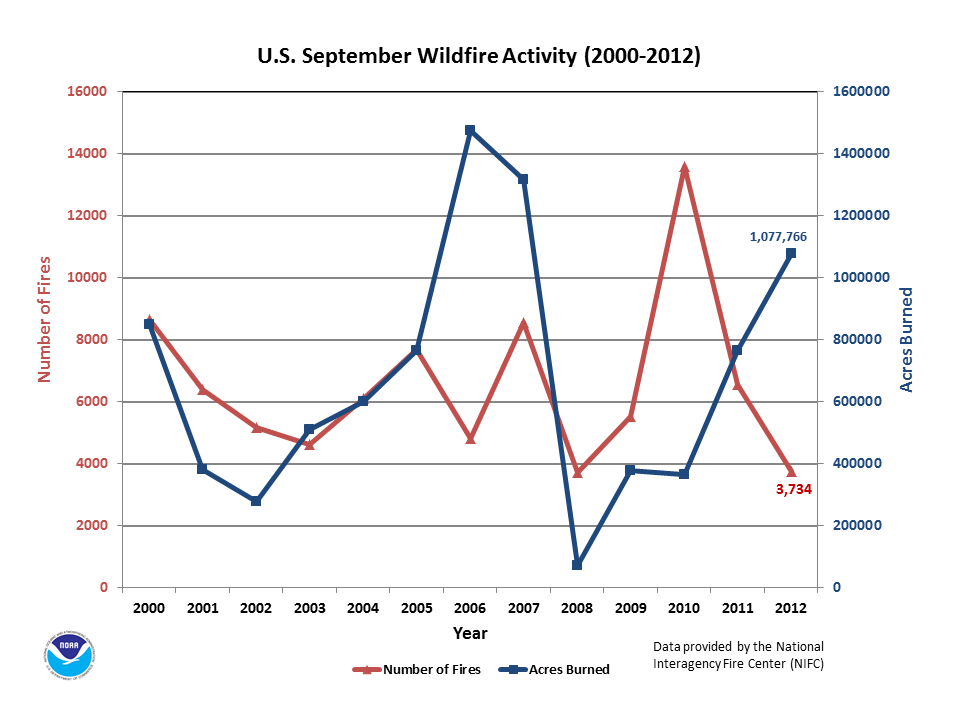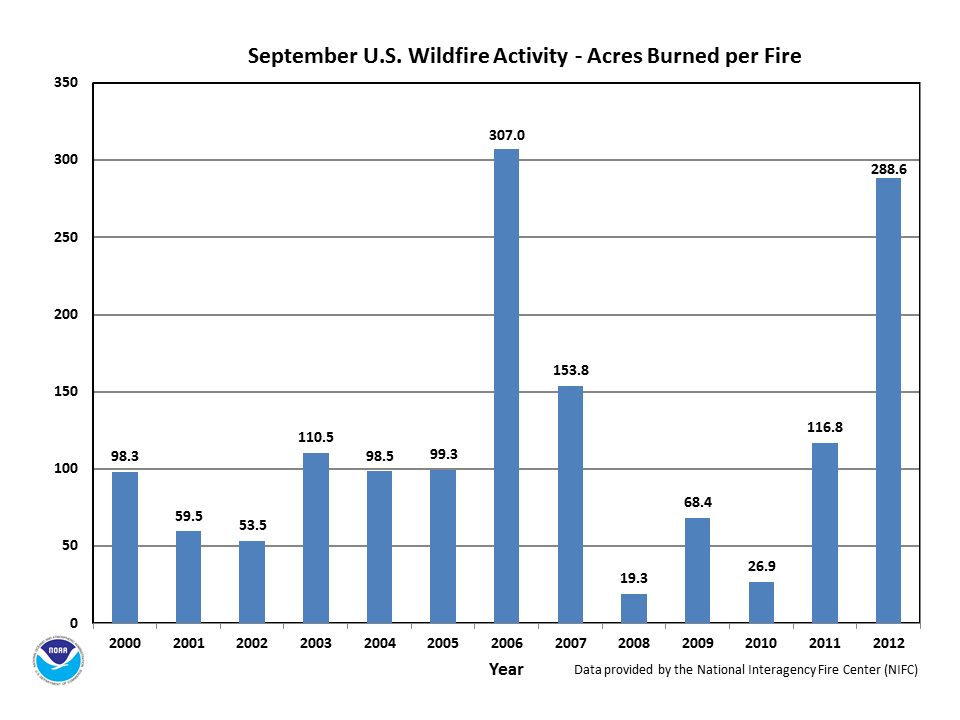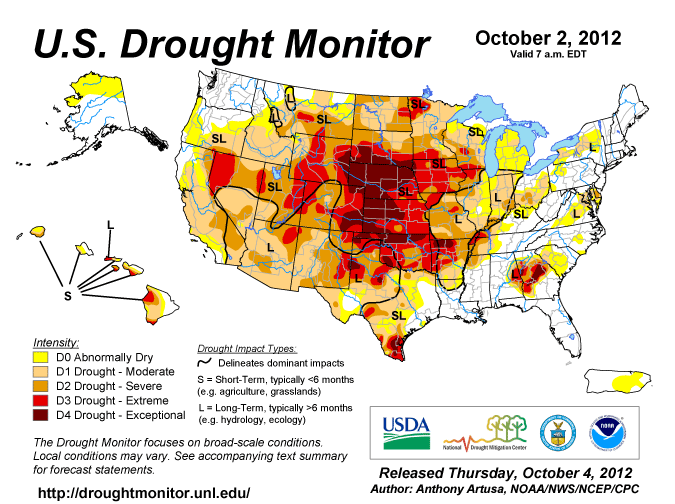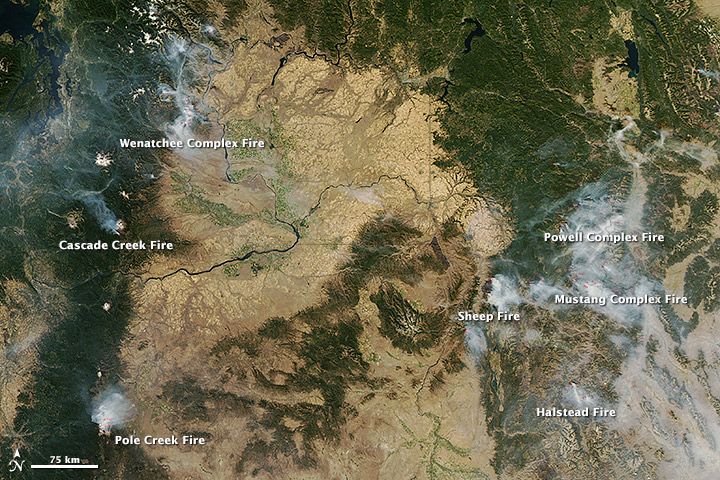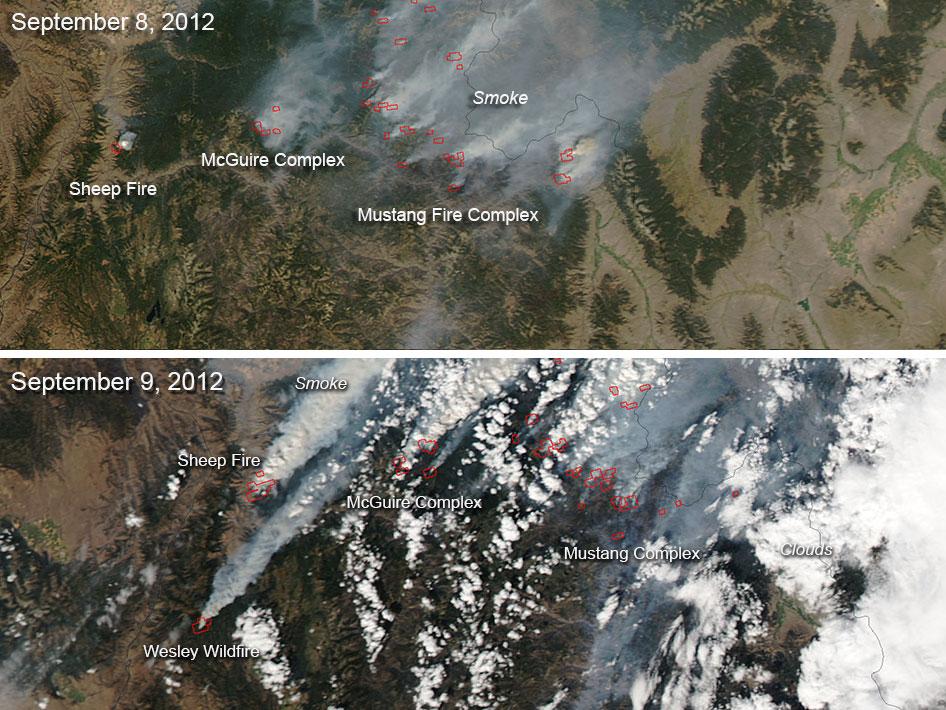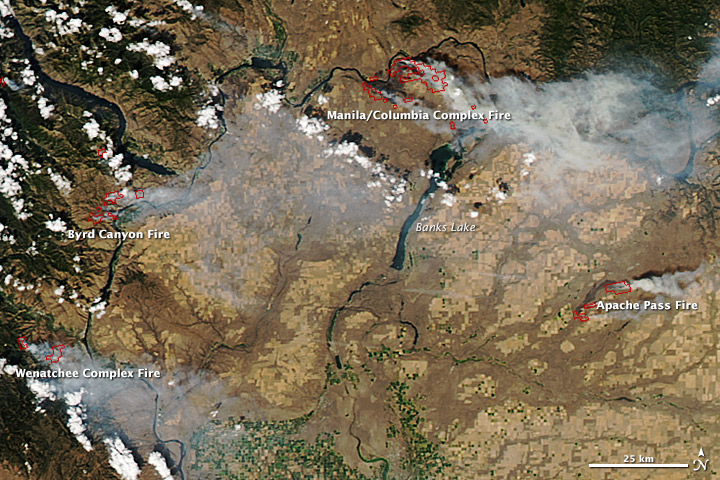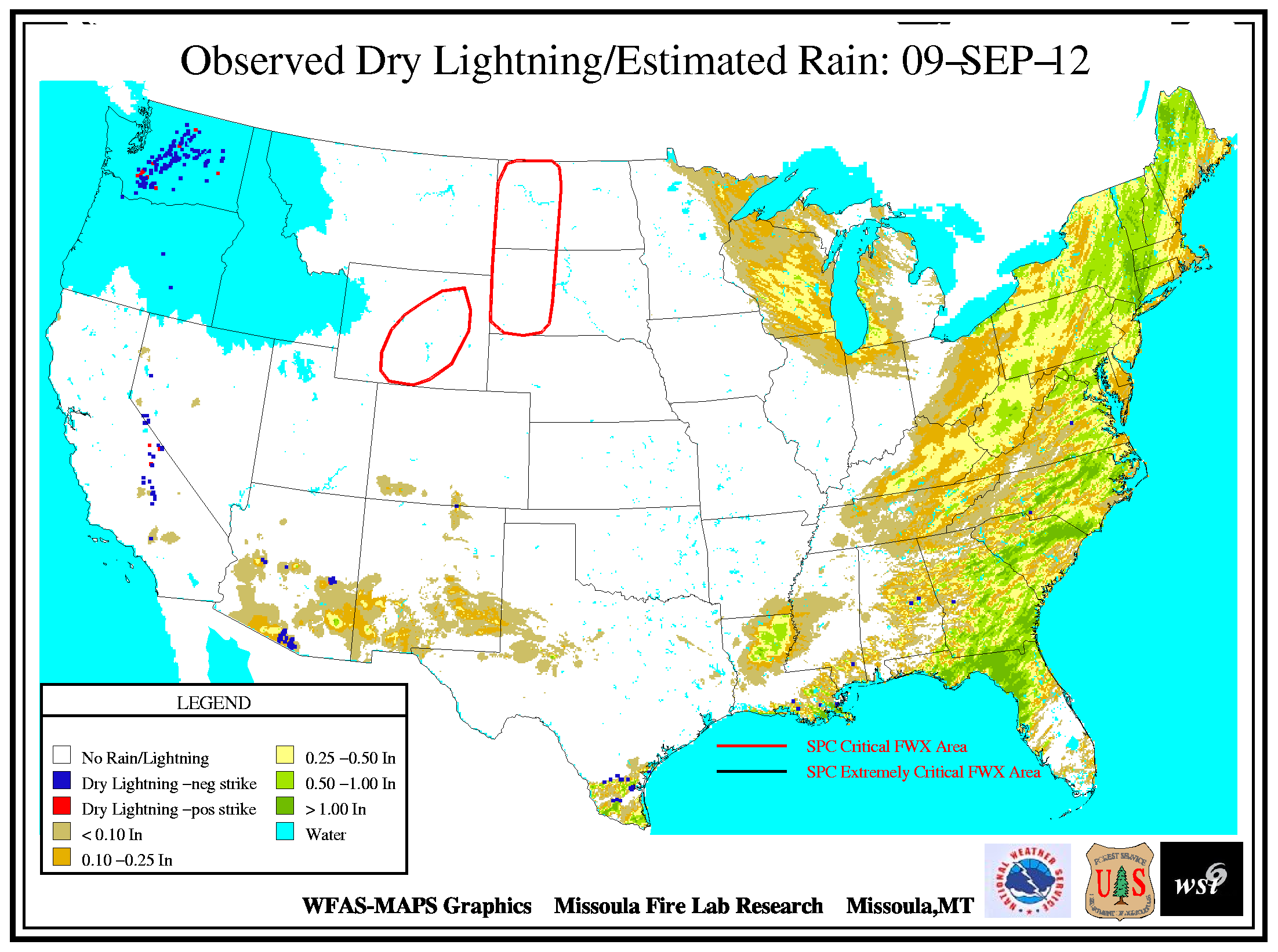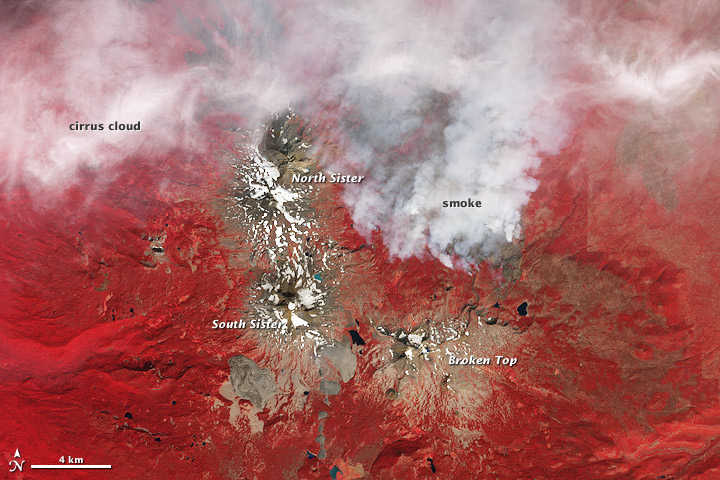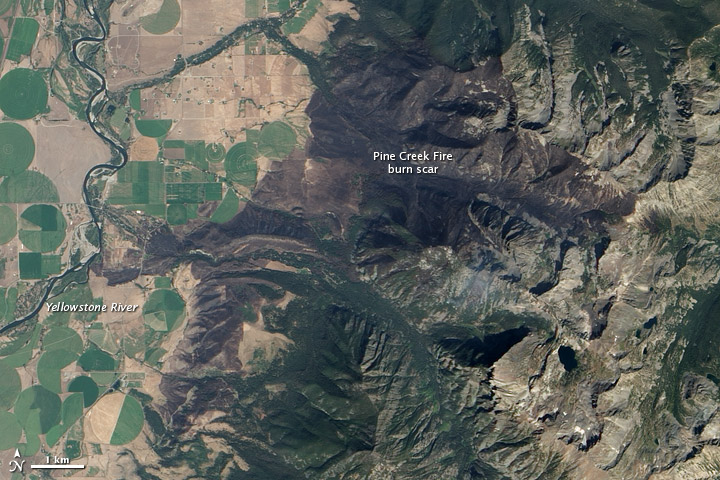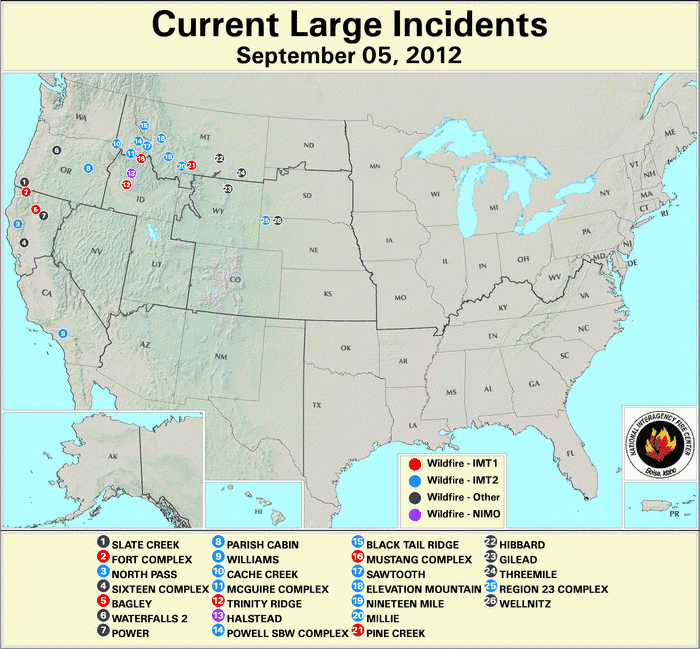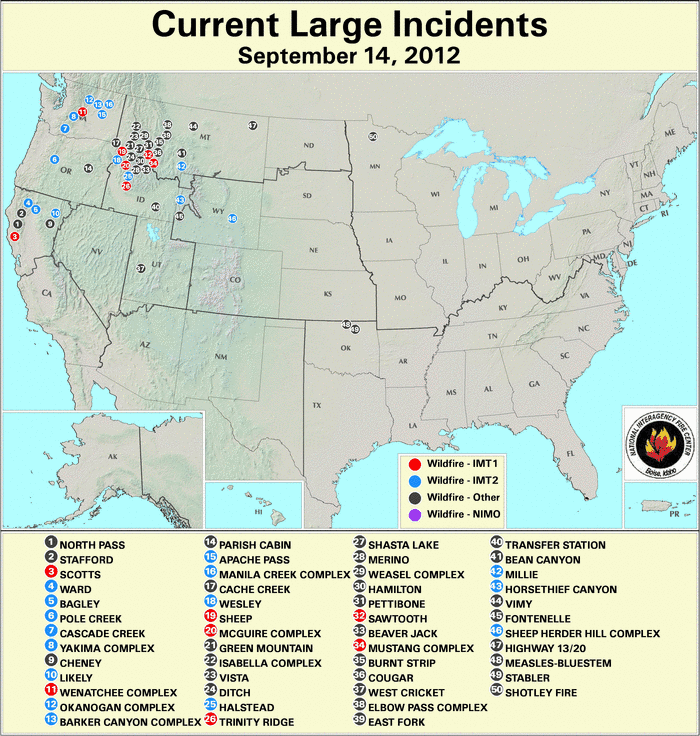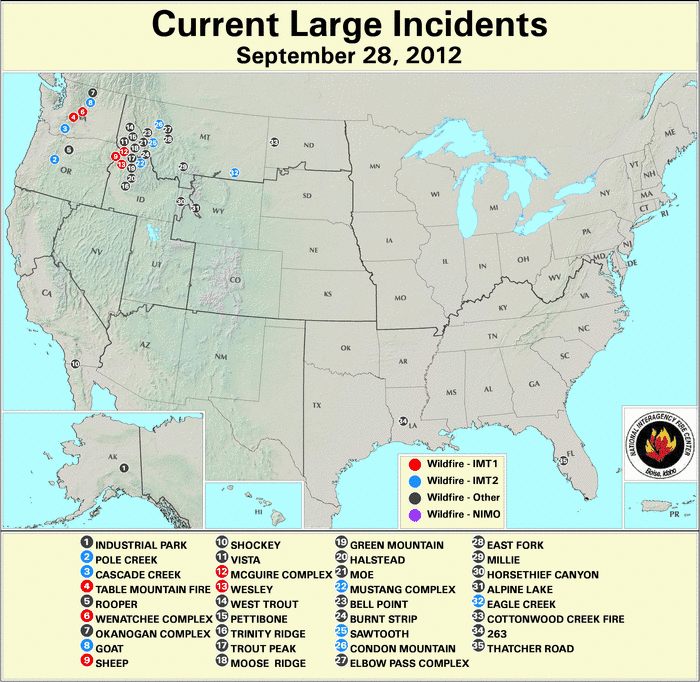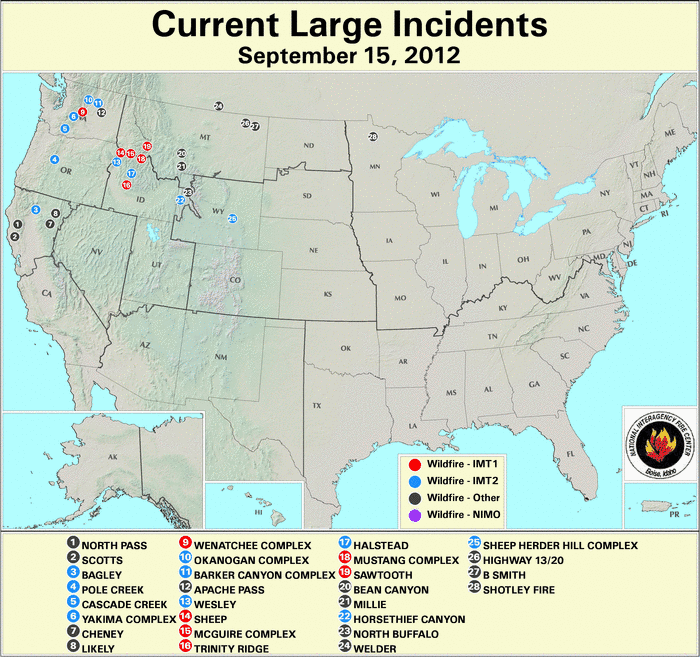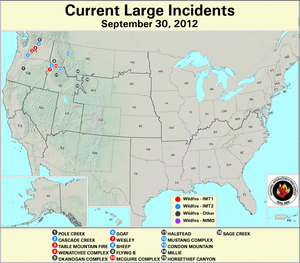Updated: 05 October 2012
Overview
Dry conditions coupled with an abundance of dry fuels contributed to the widespread extent of wildfire activity along the West Coast, the Northwest, and northern Rockies during September. The monthly average fire size reached 288.6 acres per fire — which was the 2nd highest for any September in the 2000-2012 record, second to September 2006, which had 307 acres per fire. Moreover, the year-to-date average fire size of 182.4 acres was the most since 2000 for any January through September period. The monthly total of 1.08 million acres burned by wildfires ranked as the 3rd highest for any September since 2000, while the year-to-date total acreage burned of 8.80 million acres was the 2nd highest since 2000. (The highest year-to-date total acreage burned was 9.07 million acres for the January through September period of 2006.) The monthly total number of 3,734 fires was the 2nd least for September in the thirteen-year record. Moreover, the year-to-date total number of fires was 48,258 fires and the least number since 2000 for any January through September period. Thus, the tendency of fewer fires — but larger in size — was denoted.
According to the National Interagency Fire Center (NIFC) :
For more wildfire statistics visit U.S. Wildfires.
Discussion
Throughout September, exceptional drought (D4) was concentrated over the central Great Plains, firmly gripping parts of Nebraska, Kansas, the western half of Oklahoma, and the southeastern corner of Colorado, according to the October 2, 2012, U.S. Drought Monitor. Areas of extreme to exceptional drought combined with above-average temperatures and wind events to produce large wildfires occurrences in Nebraska, South Dakota, Wyoming, Colorado, and Oklahoma during the month. Drought conditions expanded over North Dakota and northwestern Minnesota, which coincided with wildfire activity during September. The states of Montana, North Dakota, South Dakota, and Minnesota experienced the driest September on record since 1895. Above-normal precipitation fell across much of the Southeast and Gulf Coast regions as well as parts of the Southwest and southern Great Basin. The rainfall most notably eased conditions from extreme to exceptional drought into severe drought (D2) across Arkansas, Missouri, Illinois, and Indiana. Surface and root moisture rebounded in the south central and southwestern states, yet underground aquifers remained in severe drought. Hot and dry conditions in Washington and central Idaho combined with low humidity and convectively active weather to trigger extreme fire behavior. A cold front the last week of September brought thunderstorms and showers to parts of Great Basin, and northern and central Rockies, giving moderate relief to the wildfire incidents, where the states of California, Nevada, Utah, Idaho, and Wyoming experienced much-above-normal warmth during September. Please see the U.S. temperature and precipitation report for additional information.
Significant Events
Please note, this is a list of select fires that occurred during September. Additional fire information can be found through Inciweb.
Areas from central Idaho across the northern High Plains experienced wildfire activity throughout September, while numerous fires developed in the Cascade Mountain Range at mid-month. Large fires in Washington and Oregon drew upon close to 3,500 personnel, with another 800 Northwest firefighters deployed to fires in Idaho, California, and Montana. More than 100 Canadian elite firefighters provided reinforcement as part of the Northwest Wildland Fire Protection Agreement to battle a widespread outbreak of wildfires following a severe lightning event. Following several months of continuous firefighting efforts, the U.S. resources were increasingly strained to cover the extent created by the new surge in fires. Smoke from the fires continued to contribute to air quality concerns for the Northwest. Oregon's Willamette Valley residents experienced hazardous levels of air quality at mid-month, clearing by September 24th after light rains and cooler weather approached. Air Quality Index alerts reached purple for Idahoans in late September and a state-wide burn ban was in effect.
Idaho
Wildfires were concentrated in the beetle-killed forest lands of Idaho. Two large fires burning since late July were active through September. Rain falling late in the month boosted containment to 45 percent of the Mustang Complex as of October 1st, after charring more than 339,000 acres in the Bitterroot Mountains of Idaho and Montana, during which at least eight injuries resulted. Prognosis remained good for the black bear cub, a survivor of the Mustang Complex given refuge at the Snowden Wildlife Sanctuary, following rescue and veterinary treatment of severely burned paws by the Idaho Fish and Game's Wildlife Services in late August. The Halstead Fire continued to rage, having consumed nearly 180,000 acres of mixed conifer (pine, spruce, and fir) timber stands at higher elevations, and scattered pines and sage grass along the steep slopes of Salmon River Canyon, at month's end. The estimated suppression costs for the Mustang Complex and Halstead Fire incidents exceeded $36 million and $26 million U.S. dollars, respectively, through September. The Trinity Ridge Fire, ignited on August 3rd in the Boise National Forest, reached 75 percent containment as of October 1st, with some areas remaining closed to ensure public safety. The McGuire Complex (comprised of two fires, Bagley and Herman), which threatened rural communities and over 300 structures, burned over 42,000 acres in September. During the early stages of this fierce blaze, battled by U.S. Forest Service "hotshot" teams, residents of the Orogrande, Dixie, and Comstock communities were evacuated, according to media accounts. Suppression costs were estimated at over $19 million U.S. dollars in September and the wildfire was at 20 percent containment as of October 1st.
Washington
The Highway 141 Fire originated on September 5th to quickly spread through over 1,600 acres of mixed timber, brush, and grass around the Columbia River Gorge, and threatened close to 500 residences, of which 45 homes were temporarily evacuated in Klickitat County. A few days later on September 9th, the Cascade Creek Fire flared from lightning in the Gifford Pinchot National Forest. During September, the wildfire consumed nearly 17,000 acres of beetle-killed timber, while forcing evacuation of numerous trails and campgrounds, where two vehicles burned. U.S. Forest Service firefighters saved the historic Gotchen Guard Station near Mount Adams from flames by using an aluminized structure wrap on the small ranger station that has stood since 1909.
Dry lightning strikes ignited at least 80 wildfires fires across the Pacific Northwest during September 8th–9th, with Oregon receiving 41 strikes while Washington received over 3,300 strikes, according to media reports. A wildfire incident in central Washington, the Wenatchee Complex, consisted of at least 16 smaller wildfires and threatened up to 850 homes. One firefighter died as a result of efforts to contain the blaze, which consumed over 55,000 acres of timber, brush, and grass during September. The estimated suppression costs of the fire neared $28 million U.S. dollars.
Strong winds during September 10th–11th dramatically fanned the flames of the lightning-sparked Barker Canyon Complex fire which consumed over 90,000 acres of dry brush and sage near the Grand Coulee Dam during September. The wildfire destroyed 3 homes, up to 9 outbuildings, 2 power stations near the dam, and forced evacuation of over 75 residents, according to media reports. Since September 16th, the Goat Fire burned over 7,000 acres along rugged, rocky cliffs near Alta Lake in north central Washington. Local television was lost when the wildfire damaged the KSPS-TV station's antenna receiver and threatened other critical communications sites as well as about 80 homes.
Canadian firefighting forces supported four fires in Washington, including the Table Mountain Fire, the Wenatchee and Okanogan complexes, and the Goat Fire — each of which remained active at month's end.
Oregon
The Pole Creek wildfire, which charred over 26,000 acres of dead timber and understory (juniper, sage, and bitterbrush) near Sisters, Oregon, started on September 9th. The blaze burned four cars along the Pole Creek trailhead, as search teams located and helped in evacuation efforts of campers and hikers within the wilderness area. Notably, the wildfire impacted air quality for residents as nightly inversions trapped the smoke in the valley. The American Red Cross provided shelter at a local school where the air was filtered. About 6 mm (one-quarter inch) of rain falling over September 22nd–23rd helped to limit the fire's spread. Characterized as primarily an "underburn", the fire did not permanently ruin the forest. Rather, U.S. Forest Service officials cited forest thinning and fire treatment projects in recent years as having greatly mitigated the fire's impact closest to the residential community, according to media reports.
Montana
Over 8,000 acres of beetle-killed timber were consumed during September by the Pine Creek Fire in southern Montana. Five homes and several outbuildings were lost in late August when the wildfire originated. The fire swept quickly up steep, inaccessible terrain of wilderness in Gallatin National Forest, containing very dry duff and woody fuels. The fire was estimated to be 51 percent contained as of October 5th. Another Gallatin National Forest wildfire, the lightning-sparked Millie Fire, scorched over 10,000 acres as the dry understory facilitated burning of the younger, regenerated forested stands. Estimated suppression costs of the fire exceeded $10 million U.S. dollars as of the end of September.
Monthly Wildfire Conditions
Wildfire information and environmental conditions are provided by the National Interagency Fire Center (NIFC) and the U.S. Forest Service (USFS) Wildland Fire Assessment System (WFAS).
Wildfires sparked by lightning in Nebraska's panhandle during late August were bolstered by strong canyon winds to spread quickly through dry fuels (timber and grasses), with the flames tripling in extent from September 1th–2nd. Firefighting efforts proved difficult in the rugged forest terrain of northwestern Nebraska and the bordering area of South Dakota, which accommodates a diverse range of outdoor recreation (hunting, fishing, hiking, and bird-watching). The estimated suppression costs for the wildfires topped $3.2 million U.S. dollars, according to media reports. The fires coincided closely with areas of dangerously low fuel moistures (below 10 percent) for all observed intervals of the 10-hour, 100-hour, and 1000-hour fuel moistures. The Region 23 Complex — which consisted of two Nebraskan wildfires, the West Ash and Douthit — consumed over 86,000 acres to become the largest and most destructive in the state's history, according to media accounts. About 400 residents were evacuated near Chadron and Whitney. Burning ponderosa pines exploded, shooting flames up to 90 m (295 ft) and entirely killing many of the old growth trees. Although some of the native wildlife perished in the flames, the loss of canopy may potentially improve the habitat for bighorn sheep and attract new bird species. The wildfire complex was fully contained by September 11th. Meanwhile, another large wildfire that burned nearby, the Wellnitz Fire, and later crossed into South Dakota's Pine Ridge Indian Reservation, scorched over 77,000 acres between August 29th–September 7th. At least 10 homes and more than 50 structures within the two states were damaged by the fires, with two of the homes being located in Slim Buttes, South Dakota.
In southern California, the Williams Fire consumed over 4,000 acres of chaparral within the Angeles National Forest, an area of extreme moisture deficits as indicated by the Keetch-Byram Drought Index (KBDI) value in excess of 700 units. The dense brush, up to 20 years old, over rugged terrain posed a challenge to firefighting efforts, according to media reports. On September 2nd, nearly 12,000 visitors in the campgrounds were evacuated to clear access of the single road into the San Gabriel Canyon for use by fire trucks and emergency vehicles. The wildfire was fully contained as of September 13th.
A couple of large wildfires developed in Wyoming and the Dakotas at mid-month. The low 10-hour fuel moisture (under 5 percent) expanded dramatically northeastward from the Great Basin into the Great Plains. The 100-hour fuel moisture lessened over central Idaho through western Montana, dropping under 6 percent. Across the western third of the nation, the 1000-hour fuel moistures remained at or below 10 percent through the first half of September, with the exception of central Arizona.
Large fires in Wyoming coincided closely with the extremely low 10-hour fuel moisture (under 2 percent) centered over the state on September 15th. The Horsethief Canyon Fire caused disruption for many people visiting the Jackson Hole ski resort area to attend the state's annual Fall Arts Festival, where up to 1,600 residents faced potential evacuation. The blaze which raged through more than 3,000 acres of towering trees, sagebrush, and grasslands between September 8th and early October. On September 9th, the Sheep Herder Hill Fire resulted in the evacuation of nearly 500 residents near Casper, Wyoming. Gusty winds quickly spread its flames through fuels of fallen beetle-killed timbers (fir and pine) and sage, as the blaze exceeded 15,500 acres of difficult terrain prior to being fully contained by September 18th.
An area of 1000-hour fuel moisture remained below 6 percent in northern Nevada and the bordering edges of California, Idaho, and Oregon for most of the month. The Bagley Fire, which was sparked by lightning in northern California on August 18th, consumed over 46,000 acres of conifer, brush, and hardwood stands by mid-September. Deeply embedded heat within thick duff, stump holes, and large stationary fuels emitted smoke within the fire's interior. Sediment run-off into the McCloud River was a concern during the fire's suppression efforts.
The Shockey Fire, which ignited September 23rd in southern California, claimed one life, destroyed 20 homes, and damaged 15 others, according to media accounts. The American Red Cross established an evacuation shelter for residents. Damaged utility lines resulted in power outage for over 100 households.
Several wildfires developed in western North Dakota in the latter part of September as warm, dry conditions and low humidity contributed to extreme fire weather behavior. The Little Swallow Fire burned about 10,000 acres of the Berthold Indian Reservation between September 19th–25th. The Cottonwood Creek Fire, near the Theodore Roosevelt National Park, charred nearly 600 acres of juniper, sage, and short grass between September 21th–28th. Smoke-jumpers and a water-dropping helicopter assisted in battling the wildfire in the rugged badlands terrain, according to media reports. Some campground evacuations were imposed.
A couple of wildfires in Alaska prolonged the ending for the state's fire season. Strong, northeasterly winds rekindled the Dry Creek Fire in late August, and winds during September spread its flames over an additional 6,600 acres near the Tanana River. Its smoke impacted the air quality for residents of Fairbanks for a second time in the latter part of September, as the lightning-sparked wildfire scorched in excess of 47,000 acres since June 23rd. Meanwhile to the southeast of Fairbanks, the wind-driven Industrial Park wildfire blazed close to 6,000 acres of grass land from September 25th–28th.
 NOAA's National Centers for Environmental Information
NOAA's National Centers for Environmental Information
